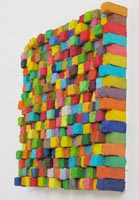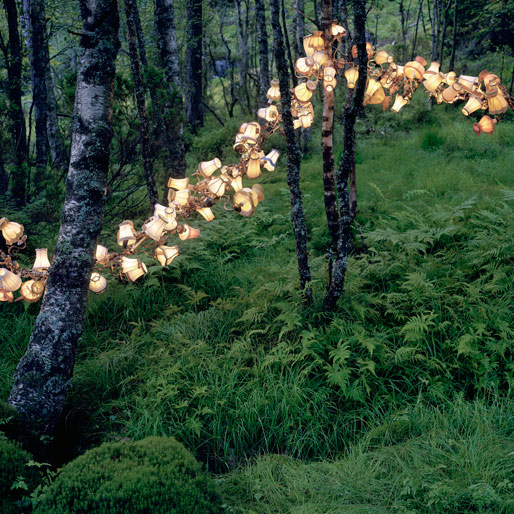Pixelated Pulse Art Fair

A prominent motif at the Pulse art fair in NYC last week, pixelation was evident in a number of works in various mediums. From afar, these works can be read as a whole, but close up, the image starts to break down and the individual elements of the composition become more dominant. Here are a selection of some of our favorites. Click on any of the images for a more detailed view.
The buzz around the Catherine Clark Gallery booth had a lot to do with "The Morning After Portraits" by Andy Diaz Hope. Made of gel-caps, the series shows images of people in front of their medicine cabinets or in their local pharmacies with hangovers, headaches and other illnesses self-inflicted or otherwise. (Pictured above right.) A more literal comment on our pill-popping culture than Damien Hirst's similar work, Hope comments, "We are no longer a sum of our natural history, but a sum of our natural history plus our self selected recreational and medical regimes."
At first glance, the installation by Devorah Sperber presented by the Marcia Wood Gallery, looks like randomly arranged different colored spools of thread. However, a clear acrylic sphere placed in front of the work shrinks and condenses the thread spool "pixels" into an easily-read image of a masterpiece—in this case Vermeer's "Girl With a Pearl Earring"—and the convex shape flips the imagery 180 degrees. A mimicry of how the brain and eye process visual data, Sperber's work plays with ideas about the past, craft, visual theories and art itself. Check out more of her work at the Brooklyn Museum until 6 May 2007.
Referencing cubists like Picasso and other early 20th-century painters, Isidro Blasco, recently exhibited at DCKT Contemporary, turns the 2-dimensional media of photography into a 3-dimensional experience by piecing together multiple photos. Using board-mounted photographs, he combines multiple angles and architecture to explore perception in relation to physical experience. Blasco's sculptures draw the observer into the piece, so that the experience of it feels new rather than a straight portrayal of the scene. The photographic sculpture pictured (right), "Side Building," measures 107 x 120 x 72 inches . See more of his work here.
More of a dot-matrix than pixels, William Betts of the Richard Levy Gallery in Albuquerque, NM, re-creates surveillance camera images by carefully dripping acrylic paint onto canvas. Using digital information, he creates work that is abstract, organic and realistic. Again, a macro view (above right) becomes an abstraction but a step back (above left) reveals a realistic surveillance camera shot. Also on Cool Hunting, Betts' work from last years Scope art fair uses digital information (and in this case techniques) to create graphics. See more from this series of work here.
Carlos Estrada-Vega, presented by Margaret Thatcher Projects, exhibited sculptural works made of small canvas-covered blocks. Estrada-Vega considers each square as its own distinct painting, hence show titles like, "4000 Paintings/14 Compositions." Given the modularity of the pixel-like pieces (they're attached with magnets), the mini-paintings have the potential to be rearranged infinitely into new compositions. The colors, inspired by the artist’s Mexican heritage, look somewhat monochromatic from afar. Only up close do the ultra-saturated colors reveal themselves, an aspect further accentuated by the topographic nature of the blocks. Maceo (far left) is composed of wax, oleopasto, oil, limestone and pigment on canvas and measures 18 x 18 inches. More effective in person, these photos do not do the works much justice.












